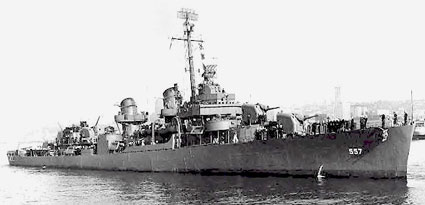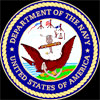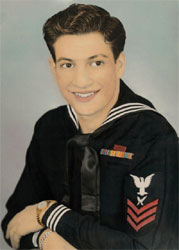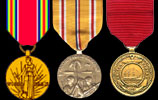| North
High School Wall of Honor Chester Ralph Rizzuto Class of June, 1943 |
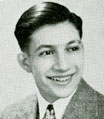 |
||||||||||||||||||||||||||||||||||||||||||||||||||||||||||||||||||||||||
| Research done by Claradell Shedd, class of 1953. | |||||||||||||||||||||||||||||||||||||||||||||||||||||||||||||||||||||||||
| Chester Ralph Rizzuto | |||||||||||||||||||||||||||||||||||||||||||||||||||||||||||||||||||||||||
| Chester Ralph Rizzuto graduated from North High in the June, 1943 class. His next of kin was shown as Mr. Sam Rizzuto, 1618 23rd Street, Des Moines, IA. Chet enlisted in the US Navy. His service number was 3218597. | |||||||||||||||||||||||||||||||||||||||||||||||||||||||||||||||||||||||||
|
|||||||||||||||||||||||||||||||||||||||||||||||||||||||||||||||||||||||||
|
|||||||||||||||||||||||||||||||||||||||||||||||||||||||||||||||||||||||||
| *Chet's
version of his Pacific Theater duty aboard the USS Johnston (DD-557): Highlights that I can remember: I graduated from North High School one month early, May, 1943, and enlisted in the regular Navy. I enlisted in Des Moines, Iowa. Was sent to Great Lakes for "Boot Camp" which lasted two months, had a two week leave to come home and on return was placed in the "Outgoing Unit" (OGU) for assignment. Three weeks later I was assigned to the USS Johnston, DD-557 which was located at Harbor Island. The Ship was commissioned in October, 1943. The complement of the ships crew was 327 men and officers. Our Captain was Commander Ernest Evans. When we boarded the ship, assignments were given. I was studying to be a signalman and was sent to school for training. A short while after, I was assigned to Fire Control, and sent to school to learn how to use the Mark 37 Director which was located above the bridge of the ship and controlled automatic or manual firing of the five inch guns. In the Director Group was our Gunnery Officer, Lieutenant Bob Hagen, and a total of four sailors of which I was one. When the complement of personnel was accomplished, the Captain told us we were going to take a "Shake Down" cruise of the ship. This entailed constant practice in every phase of the ship's operations including battle stations and firing of all guns, both manually and automatically. The ship sailed to California for this operation, and the crew became totally familiar with his duties. After the Shake Down cruise was completed, we awaited orders from the Bureau of Naval Personnel. The Captain advised the crew we were going to the Asiatic Pacific for duty and join the Third Fleet, Commanded by Admiral (Wild Bill) Halsey. Three months later, the Johnston was in the Pacific and participated in bombarding the beaches of Kwajalein, Eniwetok in support of troops on the islands. Bombardments were also made at Kapingamarangi Atoll. The ship then sailed into Maririca River, close to Bougainville in the Solomon Islands and was ordered to antisubmarine patrol off Bougainville. During this operation, one Japanese submarine was sunk by depth charges. Our patrol duty lasted approximately three months when we were ordered sail to the Marshall Islands in preparation for the invasion and capture of Guam Island. In July, 1944, the Johnston and the Battleship Pennsylvania were in action firing and destroying gun installations, pill boxes, and any other buildings. The Johnston then helped protect escort aircraft carriers which provided air support for the invasion and capture of the Palau Islands. It was during this time that preparations were being made by the United States to return to the Philippines, and the Johnston was replenishing the ship with food, ammunition, and making minor repairs. After the ship was equipped, she sailed to help once again, to protect the carriers who were maintaining air coverage over Leyte and the Gulf. The Johnston was then operating with "Taffy 3" ( Escort carrier Task Unit) which consisted of the USS Fanshaw Bay (light aircraft carrier and flagship for Admiral C. Sprague), five other escort carriers, three destroyers, one being the Johnston, and four destroyer escorts. The term "Taffy 3" was the Johnston's voice call signal for messages to be sent and received by the Ship's Captain, Commander Evans. In early morning hours, our submarines detected and attacked units of the Japanese Fleet and heading for the Leyte Beachhead. The balance of this Fleet, a Battleship-Cruiser-Destroyer force, was attacked and beaten by Admiral Halsey's attack carrier planes. During this time we did not know what the circumstances were nor the fact that Admiral Halsey's had sailed north with his attack carriers and battleships to engage a Japanese carrier- battleship task force off of Cape Engano. This left the Johnston and the remaining escort force to rely on its own. The force was in the Leyte Gulf off of the San Bernadino Strait. In the early hours of October 26, 1944, the Japanese Force slipped through the San Bernadino Strait in the Leyte Gulf and steamed along the coast of Samar, directly for the Johnson's small task unit and the American invasion forces at Leyte to bombard our amphibious shipping and American troops on shore. Observed by one of our pilots flying patrol was that a Japanese Center Force was steaming straight for "Taffy 3". This force consisted of four battleships, seven cruisers, and about twelve destroyers. This was the battle that the Johnston was at her finest hour. The Johnston began zigzagging between the six escort carriers and the Japanese Fleet putting out a smoke screen to hide the carriers from Japanese gunners. The Johnston also began to start firing all guns and launch a torpedo attack against the Japanese Fleet. The Japanese cruisers and battleships had the Johnston in range, but the Johnston's guns would not reach the Japanese. She went onward to close the enemy-first line which consisted of seven destroyers; next, one light and three heavy cruisers, then the four battleships. Coming in from the east, three other cruisers and several destroyers were seen. When the Johnston's guns were in range, she opened fire, with her 5-inch batteries on the nearest cruiser scoring damaging hits. She also expended all of her torpedoes, virtually rendering her helpless. In this final engagement (battle), the USS Johnston was instrumental in the sinking of the Japanese cruiser, KUMANO. We also lost the Destroyer HOEL (DD-533) and SAMUEL B. ROBERTS (DE-113) From the USS Johnston's complement of 327, 141 were saved, 186 were lost. The Johnston's Captain, Commander Ernest Evans, was posthumously awarded the Congressional Medal of Honor and, in addition the Johnston received six battle stars for service in World War II. |
|||||||||||||||||||||||||||||||||||||||||||||||||||||||||||||||||||||||||
|
|||||||||||||||||||||||||||||||||||||||||||||||||||||||||||||||||||||||||
| *+USS
Johnston (DD-557) USS Johnston (DD-557) was a World War II-era Fletcher-class destroyer in the service of the United States Navy. She was the first Navy ship named after Lieutenant John V. Johnston. The ship was most famous for its bold action in the Battle off Samar. The small "tincan" destroyer armed with nothing larger than 5" guns and torpedoes would lead the attack of a handful of light ships which had inadvertently been left unprotected in the path of a massive Japanese fleet led by battleships and cruisers. The sacrifices of Johnston and her little escort carrier task unit "Taffy 3" had stopped Admiral Kurita's powerful Center Force in the Battle off Samar from attacking vulnerable US landing forces, and inflicted greater losses than they suffered. During the Marshall Islands campaign, Johnston bombarded the beaches at Kwajalein 1 February 1944, and made a 5-day bombardment of Eniwetok 17–22 February. She gave direct support to invasion troops there, destroying several pillboxes and taking revetments along the beach under fire. En route to patrol duty in the Solomons 28 March 1944, she bombarded Kapingamarangi Atoll in the Carolines. An observation tower, several blockhouses, pillboxes and dugouts along the beach were shelled. Two days later she came into the mouth of the Maririca River, southeast of Empress Augusta Bay, Bougainville, Solomon Islands. After laying a heavy barrage into that area, she took up antisubmarine patrol off Bougainville. During this duty 15 May 1944, she depth charged and sank the Japanese submarine I-176. After 3 months of patrol in the Solomons, Johnston sailed to the Marshall Islands to prepare for the invasion and capture of Guam in the Marianas. On 21 July 1944, she teamed up with the Pearl Harbor "ghost", the battleship Pennsylvania, to bombard Guam. The destroyer had sent in more than 4,000 rounds of shells by 29 July. Her accurate gunfire shattered the enemy 4 inch battery installations, numerous pillboxes and buildings. Johnston next helped protect escort carriers providing air support for the invasion and capture of the Palau Islands. Now the time had come for General MacArthur's long awaited return to the Philippines. Following replenishment at Seeadler Harbor, Admiralty Islands, she sailed 12 October 1944 to help protect the escort carriers maintaining air supremacy over eastern Leyte and the Gulf, sweeping the enemy off local airfields, giving troops direct support on the landing beaches from 20 October, and even destroying vehicle transport and supply convoys on the roads of Leyte itself. Johnston was operating with "Taffy 3" (Escort Carrier Task Unit 77.4.3) comprising Rear Admiral Clifton A. F. “Ziggy” Sprague's flagship Fanshaw Bay, five other escort carriers, three destroyers including herself, and four destroyer-escorts. "Taffy 3" was one of the three units of Rear Admiral Thomas L. Sprague's Escort Carrier Task Group 77.4, known by their voice calls as "Taffy 1", "Taffy 2", and "Taffy 3". On the morning of 23 October 1944, American submarines detected and attacked units of the Japanese fleet coming in from the South China Sea toward the precarious Leyte beachhead. The battleship-cruiser-destroyer Southern Force was decimated as it attempted to enter Leyte Gulf via Surigao Strait the night of 24–25 October 1944. The more powerful battleship-cruiser-destroyer Center Force under Vice Admiral Takeo Kurita had been pounded by Admiral “Bull” Halsey's attack carrier planes and presumably turned back from San Bernardino Strait. Admiral Halsey then raced north with his attack carriers and heavy battleships to engage a decoy Japanese carrier–battleship task force off Cape Engano. This left Johnston and her small escort carrier task unit lonely sentinels in north Leyte Gulf, east of Samar and off San Bernardino Strait. As enemy ships fled the Battle of Surigao Strait at daybreak of 25 October 1944, the powerful Japanese Center Force slipped through San Bernardino Strait and into Leyte Gulf. It steamed along the coast of Samar directly for Johnston’s little task unit and the American invasion beachhead at Leyte, hoping to destroy amphibious shipping and American troops on shore. One of the pilots flying patrol after dawn alert of 25 October 1944 reported the approach of Japanese Center Force. Steaming straight for "Taffy 3" were four battleships (including Yamato), seven cruisers, and at least 12 destroyers. Johnston's gunnery officer, Lieutenant Robert C. Hagen, later reported, "We felt like little David without a slingshot." In less than a minute, Johnston was zigzagging between the six escort carriers and the Japanese fleet and putting out a smoke screen over a 2,500-yard front to conceal the carriers from the enemy gunners: "Even as we began laying smoke, the Japanese started lobbing shells at us and the Johnston had to zigzag between the splashes.... We were the first destroyer to make smoke, the first to start firing, the first to launch a torpedo attack...." For the first 20 minutes, Johnston could not return fire as the enemy cruisers and battleships' heavy guns outranged the Johnston's 5-inch guns. Not waiting for orders, Commander Evans broke formation, and went on the offensive by ordering Johnston to speed directly towards the enemy—first a line of seven destroyers, next one light and three heavy cruisers, then the four battleships. To the east appeared three other cruisers and several destroyers. As soon as range closed to within ten miles, Johnston fired on the nearest vessel, Kumano, scoring damaging hits. In five furious minutes, Johnston fired over 200 rounds at the enemy, then, under the direction of torpedo officer Lieutenant Jack K. Bechdel, made a torpedo attack. She got off ten torpedoes, then turned to retire behind a heavy smoke screen. When she came out of the smoke a minute later, Kumano could be seen burning furiously from a torpedo hit; her bow had been blown completely off, and she was forced to withdraw. Around this time, Johnston took three 14-inch shell hits from Kongo, followed closely by three 6-inch shells, from either a light cruiser or possibly the Yamato, hitting the bridge. The hits resulted in the loss of all power to the steering engine and all power to the three 5-inch guns in the after part of the ship, and rendered the gyrocompass useless. A rainstorm came up and Johnston "ducked into it" for a few minutes of rapid repairs and salvage work. The bridge was abandoned and Commander Evans, who had lost two fingers on his left hand, went to the aft steering column to conn the ship. At 7:50 a.m., Admiral Sprague ordered destroyers to make a torpedo attack: "small boys attack". Johnston, unable to keep position with her damaged engine, and with her torpedoes already expended, nonetheless moved to provide fire support for the other destroyers. As she emerged from a smoke screen, she nearly collided with Heermann. At 8:20, Johnston sighted a Kongo-class battleship, only 7,000 yards away, emerging through the smoke. The destroyer opened fire, scoring multiple hits on the superstructure of the much larger ship. The return fire from the battleship missed clearly. Johnston soon observed Gambier Bay under fire from an enemy cruiser, and engaged the cruiser in an effort to draw her fire away from the carrier. Johnston scored four hits on the heavy cruiser, then broke off as the Japanese destroyer squadron was seen closing rapidly on the American escort carriers. Johnston engaged the lead ship until it quit, then the second until the remaining enemy units broke off to get out of effective gun range before launching torpedoes, all of which went wild. Then the luck of the Johnston ran out – she came under heavy fire from multiple enemy ships, and right when it was most needed, the damaged remaining engine quit, leaving Johnston dead in the water. Under attack from all sides. The enemy ships closed in for an easy kill, pouring fire into the crippled destroyer. Johnston took a hit which knocked out one forward gun and damaged another, and her bridge was rendered untenable by fires and explosions resulting from a hit in her 40 mm ready ammunition locker. Evans, who had shifted his command to Johnston’s fantail, was yelling orders through an open hatch to men turning her rudder by hand. Crewmen from Samuel B. Roberts spotted Evans at the fantail, asking "isn't that their captain", waving to them with what they did not realize was his only good hand. At one of her batteries, a crewman kept calling "More shells! More shells!" Still the destroyer battled to keep the Japanese destroyers and cruisers from reaching the five surviving American carriers: "We were now in a position where all the gallantry and guts in the world couldn't save us, but we figured that help for the carrier must be on the way, and every minute's delay might count.... By 9:30 we were going dead in the water; even the Japanese couldn't miss us. They made a sort of running semicircle around our ship, shooting at us like a bunch of Indians attacking a prairie schooner. Our lone engine and fire room was knocked out; we lost all power, and even the indomitable skipper knew we were finished. At 9:45 he gave the saddest order a captain can give: 'Abandon Ship.'... At 10:10 Johnston rolled over and began to sink. A Japanese destroyer came up to 1,000 yards and pumped a final shot into her to make sure she went down. A survivor saw the Japanese captain salute her as she went down. That was the end of Johnston." From Johnston's complement of 327, only 141 were saved. Of 186 lost, about 50 were killed by enemy action, 45 died on rafts from battle injuries; and 92, including Cmdr. Evans, got off the Johnston before she sank, but were never heard from again. |
|||||||||||||||||||||||||||||||||||||||||||||||||||||||||||||||||||||||||
|
|||||||||||||||||||||||||||||||||||||||||||||||||||||||||||||||||||||||||
|
|||||||||||||||||||||||||||||||||||||||||||||||||||||||||||||||||||||||||
| 08/24/10. Died 08/06/10. | |||||||||||||||||||||||||||||||||||||||||||||||||||||||||||||||||||||||||
| Music: "Anchors Aweigh" by the U.S. Navy Band | |||||||||||||||||||||||||||||||||||||||||||||||||||||||||||||||||||||||||
| Home
|
Back/allyears |
WWI |
WWII |
Korea |
Vietnam |
Afghanistan/Iraq |
Lyrics
|
Refs/Awards |
Contact ©2025-csheddgraphics All rights reserved. All images and content are © copyright of their respective copyright owners. |
|||||||||||||||||||||||||||||||||||||||||||||||||||||||||||||||||||||||||
